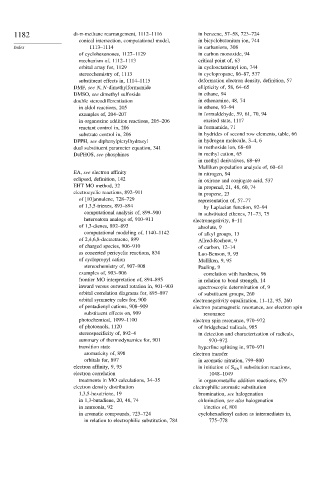Page 1195 - Advanced Organic Chemistry Part A - Structure and Mechanisms, 5th ed (2007) - Carey _ Sundberg
P. 1195
1182 di- -methane rearrangement, 1112–1116 in benzene, 57–58, 723–724
conical intersection, computational model, in bicyclobutonium ion, 744
Index 1113–1114 in carbanions, 308
of cyclohexenones, 1127–1129 in carbon monoxide, 94
mechanism of, 1112–1113 critical point of, 63
orbital array for, 1129 in cyclooctatrienyl ion, 744
stereochemistry of, 1113 in cyclopropane, 86–87, 537
substituent effects in, 1114–1115 deformation electron density, definition, 57
DMF, see N N-dimethylformamide ellipticity of, 58, 64–65
DMSO, see dimethyl sulfoxide in ethane, 94
double stereodifferentiation in ethenamine, 48, 74
in aldol reactions, 205 in ethene, 93–94
examples of, 204–207 in formaldehyde, 59, 61, 70, 94
in organozinc addition reactions, 205–206 excited state, 1117
reactant control in, 206 in formamide, 71
substrate control in, 206 in hydrides of second row elements, table, 66
DPPH, see diphenylpicrylhydrazyl in hydrogen molecule, 3–4, 6
dual substituent parameter equation, 341 in methoxide ion, 68–69
DuPHOS, see phosphines in methyl cation, 65
in methyl derivatives, 68–69
Mulliken population analysis of, 60–61
EA, see electron affinity in nitrogen, 94
eclipsed, definition, 142 in oxirane and conjugate acid, 537
EHT MO method, 32 in propenal, 21, 48, 60, 74
electrocyclic reactions, 892–911 in propene, 23
of [10]annulene, 728–729 representation of, 57–77
of 1,3,5-trienes, 893–894 by Laplacian function, 92–94
computational analysis of, 899–900 in substituted ethenes, 71–73, 75
heteroatom analogs of, 910–911 electronegativity, 8–11
of 1,3-dienes, 892–893 absolute, 9
computational modeling of, 1140–1142 of alkyl groups, 13
of 2,4,6,8-decatetraene, 899 Allred-Rochow, 9
of charged species, 906–910 of carbon, 12–14
as concerted pericyclic reactions, 834 Luo-Benson, 9, 95
of cyclopropyl cation Mulliken, 9, 95
stereochemistry of, 907–908 Pauling, 9
examples of, 903–906 correlation with hardness, 96
frontier MO interpretation of, 894–895 in relation to bond strength, 14
inward versus outward rotation in, 901–903 spectroscopic determination of, 9
orbital correlation diagrams for, 895–897 of substituent groups, 260
orbital symmetry rules for, 900 electronegativity equalization, 11–12, 95, 260
of pentadienyl cations, 908–909 electron paramagnetic resonance, see electron spin
substituent effects on, 909 resonance
photochemical, 1099–1100 electron spin resonance, 970–972
of photoenols, 1120 of bridgehead radicals, 985
stereospecificity of, 892–4 in detection and characterization of radicals,
summary of thermodynamics for, 901 970–972
transition state hyperfine splitting in, 970–971
aromaticity of, 898 electron transfer
orbitals for, 897 in aromatic nitration, 799–800
electron affinity, 9, 95 in initiation of S RN 1 substitution reactions,
electron correlation 1048–1049
treatments in MO calculations, 34–35 in organometallic addition reactions, 679
electron density distribution electrophilic aromatic substitution
1,3,5-hexatriene, 19 bromination, see halogenation
in 1,3-butadiene, 20, 48, 74 chlorination, see also halogenation
in ammonia, 92 kinetics of, 801
in aromatic compounds, 723–724 cyclohexadienyl cation as intermediates in,
in relation to electrophilic substitution, 784 775–778

